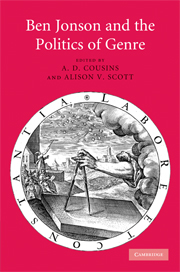Book contents
- Frontmatter
- Contents
- Notes on contributors
- Acknowledgements
- Introduction
- Chapter 1 Feigning the commonwealth: Jonson's Epigrams
- Chapter 2 The Jonsonian masque and the politics of decorum
- Chapter 3 The politics (and pairing) of Jonson's country house poems
- Chapter 4 Style, versatility, and the politics of the epistles
- Chapter 5 Jonson's politics of gender and genre: Mary Wroth and ‘Charis’
- Chapter 6 Jonson's metempsychosis revisited: patronage and religious controversy
- Chapter 7 Jonson's humanist tragedies
- Chapter 8 A generic prompt in Jonson's Timber, or Discoveries
- Bibliography
- Index
Chapter 8 - A generic prompt in Jonson's Timber, or Discoveries
Published online by Cambridge University Press: 30 June 2009
- Frontmatter
- Contents
- Notes on contributors
- Acknowledgements
- Introduction
- Chapter 1 Feigning the commonwealth: Jonson's Epigrams
- Chapter 2 The Jonsonian masque and the politics of decorum
- Chapter 3 The politics (and pairing) of Jonson's country house poems
- Chapter 4 Style, versatility, and the politics of the epistles
- Chapter 5 Jonson's politics of gender and genre: Mary Wroth and ‘Charis’
- Chapter 6 Jonson's metempsychosis revisited: patronage and religious controversy
- Chapter 7 Jonson's humanist tragedies
- Chapter 8 A generic prompt in Jonson's Timber, or Discoveries
- Bibliography
- Index
Summary
Students of Jonson's Timber have long found themselves drawn in opposite directions. On the one hand, they are chary of making any large claim for the work's merit, ever mindful of the derivative nature of much of the text. In 1907 Percy Simpson wrote of the Discoveries, ‘I doubt if they contain a single original remark.’ The year before in a thesis at Paris Maurice Castelain went so far as to contend ‘that the Discoveries might be, without any serious objection, left out of the Jonsonian canon; that, practically, the book is not his; or, at least, the merit and interest of it are for the most part attributable to other men’.
Identification of new sources has proceeded apace in the past century, as with Margaret Clayton's identification of John of Salisbury as the source for Jonson's treatment of flattery. The temptation is to leave the text to its own second-handedness and talk about other things – or to use it for source material (that's what Timber means here, initially) but never study the piece on its own: to look through it but not at it. On the other hand, readers of Jonson find something attractive and compelling in the Discoveries, though what they find differs vastly from reader to reader. George Parfitt has given a strong portrait of the authorial voice in Timber as that of a melancholy sage. Jennifer Brady in a fine article offers a thoroughly different version of the man: he is a ‘progenitor … capable of identifying with his heirs’ need to convert humanist legacies to their own use. Discoveries encourages its readers to assimilate, to emulate, and to dissent.'
- Type
- Chapter
- Information
- Ben Jonson and the Politics of Genre , pp. 190 - 197Publisher: Cambridge University PressPrint publication year: 2009

